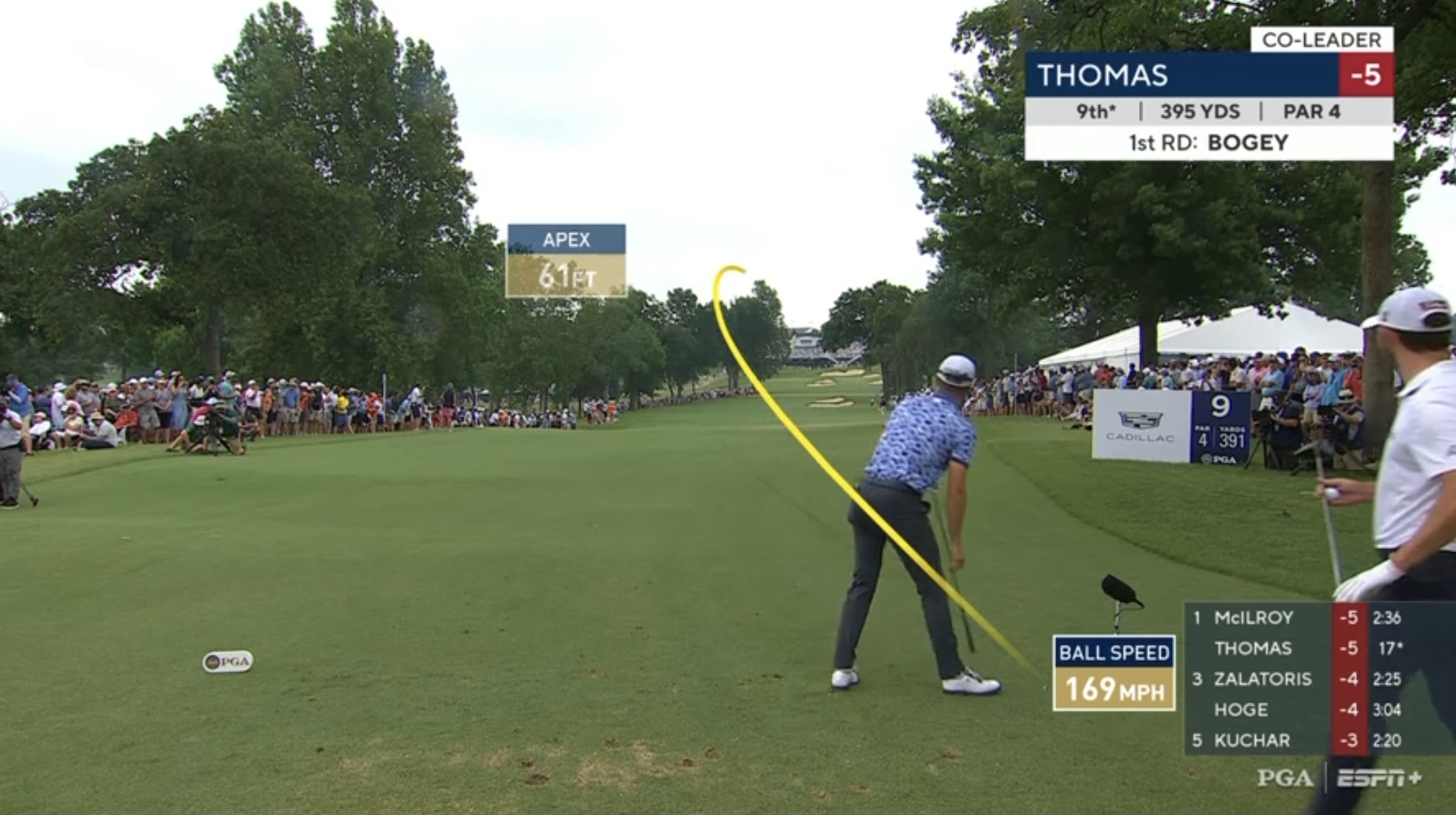As we settle in for a weekend at the PGA Championship, here are three short stories from the grounds at Southern Hills Country Club:
JT vs. the crosswinds
Justin Thomas arrived at the seventh tee at Southern Hills in decent shape. Despite blustery conditions in the morning, he stood two-under on the day and five-under on the tournament. He had three holes left in his second round, and since he had started on the back nine, they were Nos. 7, 8, and 9. These were the fourth, sixth, and fifth hardest holes, respectively, on Friday at the PGA Championship. And the wind wasn’t letting up.
“Something very unique about this course is you don’t have very many holes that are directly downwind or directly into the wind,” Thomas said afterwards. “You have a lot of crosswinds, so your ball is doing a lot of curving as it’s in the air.”
Perhaps no one in men’s professional golf is better equipped to handle crosswinds than Thomas. He’s one of the most skilled iron players in the game, capable of hitting the ball high, low, left to right, and right to left. He can also execute a range of trajectories and shapes with the driver. JT’s versatility was on full display earlier this year at the Players Championship, when he recorded a second-round 69 in the highest winds we’ve seen at a big U.S. tournament in recent memory.
“The wind that day was absurd,” Thomas said. “I would have to say that was more difficult.”
But his performance on the first two days of this PGA Championship was, in some ways, just as impressive.
Things could have gone sideways during his last three holes on Friday. He yanked his tee shot into the left rough on No. 7, leaving himself one of the scariest recoveries on the course. His ball was in sticky Bermuda rough, and from that angle, the green tilts away from the player, toward a creek on the right. Bailing out left isn’t a good option, either: there are two bunkers and a sharp run-off on that side.
Thomas hit it heavy. Or at least that’s what it sounded and looked like. Although he had a short iron in his hands, the ball came out low. It landed well short of the bunker guarding the front-left corner of the green. And then it bounced—high and forward. On its second hop, it skirted the right edge of the bunker and rolled onto the green, 30 feet from the pin. He had found the only available path, and it was a narrow one. Push it right and you’re in the creek; pull it a touch and you’re bunkered; land it anywhere but where Thomas did and you’re long.
Asked about this kind of shot-making after his round, he said, “I think it’s definitely more important some weeks than others. You get to a place like Palm Springs, where the wind doesn’t blow and the greens are pretty soft, it’s just see pin, hit pin, and go from there.”

Justin Thomas used a variety of trajectories and shapes to get off the tee and finish his round with the clubhouse lead
In Southern Hills’ unpredictable gusts, the target is rarely the aiming point. On the par-3 eighth hole, Thomas hit a high long iron that rode a quartering right-to-left headwind to the middle of the green. On the ninth hole, he teed it low and his a squeeze fade with his driver that held against a wind coming directly off the right. A gap wedge and a birdie putt later, he posted his second straight 67.
Justin Thomas (-6) won’t be in the final pairing on Saturday. Will Zalatoris (-9) and Mito Pereira (-8) benefited from tee times on Thursday morning and Friday afternoon, when the weather was calmer. But if the weekend brings more crosswinds, it’s hard to imagine anyone having a better chance than this generation’s leading shot-shaper.
Cautious Kerry
When I stepped outside my Airbnb in Tulsa on Friday morning, I had one word on my mind: carnage. It was 7 a.m., and the trees were already swaying. The forecast called for gusts up to 40 mph and lots of bogeys in the second round of the PGA Championship.
But by mid-morning, it was clear that something strange was happening: scoring wasn’t ballooning. Sure, some players were struggling, but by the end of the morning wave of tee times, only three—Daniel Berger and two club pros—failed to break 80. No one was putting off greens or chipping into bunkers. No one was defaming the PGA of America in post-round press conferences.
That’s when word started to spread that the PGA’s setup crew, led by Chief Championships Officer Kerry Haigh, had elected not to mow the greens the night before in anticipation of high winds. The scoring average was about the same as it had been the day before. Smart, everyone said. Sensible.

The PGA of America's leaders, from left to right: Seth Waugh, Jim Richerson, and Kerry Haigh
And I can’t disagree. Kerry Haigh has earned his reputation as a steady, competent setup czar who never allows his job performance to become a major storyline. Southern Hills, as he and club superintendent Russ Myers have presented it this week, is a terrific test of golf. A deserving champion will be celebrated on Sunday.
But come on. Don’t you wish you saw a little carnage?
Tiger vs. the cut
“Hey, you look good, Tiger!” a fan called from the side of the 12th fairway at Southern Hills.
Tiger Woods did not look good. His post-car-crash limp is familiar now, his right leg hovering for a moment before moving into stride, as if his conscious mind has to override his body’s warning to stop. Later, after hitting his layup second shot on the 13th hole, he winced so hard that the crowd gasped.
But Tiger was hanging around the cut line. It was looking like +4 would make the weekend, and he arrived at the 10th tee +4 on the tournament. The wind, which had gusted hard earlier in the day, had died down. So the question was whether Tiger could summon enough moments of brilliance to play his last nine holes in even par.
He would need nothing less than moments of brilliance because the bad swings were inevitable. His tee shot on the 178-yard 11th hole sailed long and left and barely stayed in play, leading to a double bogey. He stubbed a chip from the closely mown Bermudagrass surrounds of the 14th green, and he dumped his wedge shots on Nos. 12 and 15 into green-side bunkers—mistakes that a healthy Tiger with sufficient competitive reps wouldn’t have made more than once or twice a round.
But after that chip on 14, he made the putt. And after those missed greens on 12 and 15, he got up and down for par. He was grinding, stone-faced. His wedge approach into the 13th green came out strikingly low, a trap draw that took one sideways hop and stopped eight feet from the pin. On the 16th hole, he hit a vintage Woodsian mid-iron to four feet. He made 60 feet and two inches of putts over his last nine holes, and he finished one shot inside the cut line.
It was both inspiring and disconcerting to see Tiger work so hard and put himself through such agony just to make a cut. Back in his prime, between 1998 and 2005, he advanced to the weekend rounds in 142 consecutive events, a record that will likely never fall. But on Friday at the PGA Championship, making a single major-championship cut somehow felt like an equally momentous achievement.
MORE PGA COVERAGE FROM THE FRIED EGG
- A video with Gil Hanse on what the pros will confront at Southern Hills
- The Restoration: Southern Hills and the future of championship golf
- A PGA Primer on the traits and challenges of Southern Hills
- Spieth’s shot at the slam comes with a new weapon
- What to Know About Perry Maxwell: The life, work, and philosophy of the architect behind Southern Hills
- Oklahoma and Maxwell-themed T-shirts for the 2022 PGA


 by
by 
